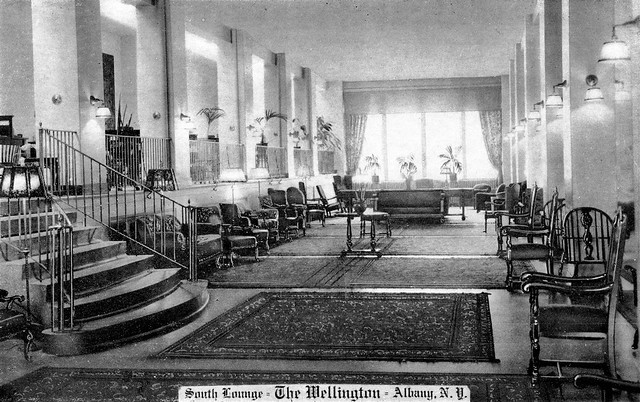1) The first location on my tour is the Suny Administration Building formerly know as the Delaware and Hudson Building (D&H). During the twentieth century, the D&H Building was the centerpiece of Albany. Albany city was the heart of major river ports as well as a major railroad center. The D&H building played a significant role to the history of railroads because it was one of the largest railroad headquarter. The building was also home to two of the most important railroad tracks, the New York Central and the Delaware&Hudson. My second location is the Key Bank formerly known as the National Commercial Bank. The bank was first founded in 1825 as the Commercial Bank of Albany and its main function was to issue and circulate bank bills. In 1865 the bank became organized as a national bank and renamed to the National Commercial Bank. The bank is significant because it became the financial stronghold of Albany and was a determining factor for many of Albany’s businesses to prosper. The third location is Old Elm Tree, although the tree no longer exits it’s a significant landmark of Albany’s history. The Old Elm Tree once stood in-front the home of Philip Livingston, a signer of the Declaration of Independence. After the removal of the tree in 1877 the corner became home to many different establishments. The fourth location is the Wellington Hotel. This hotel was a symbol for respectable guest such legislatures and officialdom. Today, the hotel is an abandon building that is in the process of being demolished. My last location is the Albany Law school. Although the school no longer exist at this location during the early 1900’s this was the home to many Albany law students and is considered one of the oldest independent law school
- “Albany Law School.” The History of. Accessed February 28, 2016. http://www.albanylaw.edu/about/history/Pages/default.aspx.
- Belinski, Stefan. “Elm Tree Corner.” Elm Tree Corner. 2001. Accessed February 28, 2016. https://www.nysm.nysed.gov/albany/loc/elmtreecorner.html.
- Prescott, Herbert F. “The National Commercial Bank of Albany: A Brief History of Three-quarters of a Century, Its Officers and Directors”. Albany, NY: Weed, Parsons, 1901. Accessed February 29, 2015. https://play.google.com/books/reader? id=VnkpAAAAYAAJ&printsec=frontcover&output=reader&hl=en&pg=GBS.PA34.
- “The D&H Building.” The D&H Building. 1993. Accessed February 28, 2016. http://www.albany.edu/museum/wwwmuseum/statestreet/dhbuild.html.
- “Wellington Hotel-State Street, Albany, NY.” Wellington Hotel-State Street, Albany, NY. Accessed February 28, 2016. http://lostlandmarks.org/wellingtonmain.html.
2) Google estimates my tour to take 17 minutes
3) For my tour I decided to focus on a specific area of downtown Albany. I chose State Street as my topic because it was a familiar area to me. Although I am not personally from Albany I felt that State Street was a common location and therefore my tour would attract more audiences. The theme of my tour is “What Are They Now” aside from each location being on the same street, they all were locations that once represented something different from what they do now. For example, the B&H building initial purpose was for railroads, but today it’s know as the Suny Administration Building. As for my intended audience, I feel as though my tour can entertain and educate any age group and gender. In addition, the short length of my tour also attracts more audience. My audience can range from a person whose on their lunch break, or just someone who has free time and wants to learn more about Albany. Although there are few limitations on who my intended audience is, I do feel as though local residents who are familiar with the State Street area can benefit more than none local residents. I believe this because being familiar with the area makes a person curious to learn more about the history of their own neighborhood. After my tour I want my audience to feel as though they physically have went back in time. The whole point of not having a specific topic, but a specific area to focus on is so that my audience can feel as though they have learned a little bit more of Albany’s overall history. My idea to show a then and now of my five location is to show my audience the evolution and progress Albany has made from the eighteenth/nineteenth century to present day. I hope my audience not, only take away historical facts, but also leave my tour feeling a sense of pride for being a part of a city filled with so much history.
4) D & H Building
Wellington Hotel
5) What happen to the once prosperous Wellington Hotel that made it become an abandoned building?
Why did the Albany Law school move from its initial building?
Why did the National Commercial Bank stop printing money?
